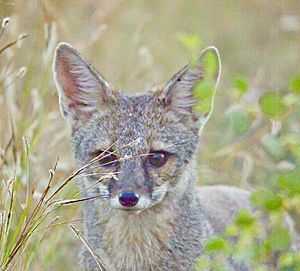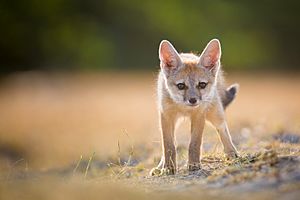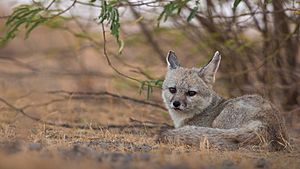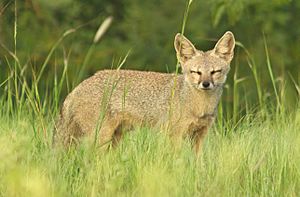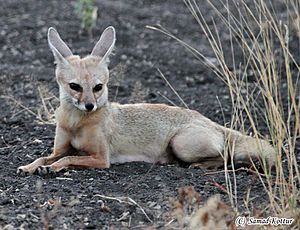Bengal fox facts for kids
Quick facts for kids Bengal fox |
|
|---|---|
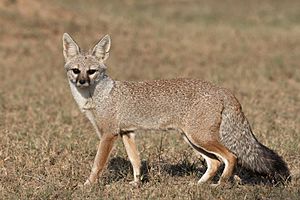 |
|
| Bengal fox in Thar Desert, Rajasthan | |
| Conservation status | |
| Scientific classification | |
| Genus: |
Vulpes
|
| Species: |
bengalensis
|
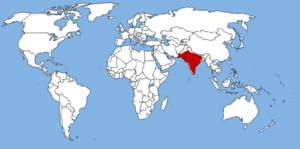 |
|
| Range map | |
| Synonyms | |
|
Canis kokree,Canis rufescens, Canis indicus, Vulpes xanthura |
|
The Bengal fox (Vulpes bengalensis), also known as the Indian fox, is a type of fox that lives only in the Indian subcontinent. You can find it from the Himalayan foothills in Nepal all the way through southern India. It also lives in parts of southern and eastern Pakistan, eastern India, and southeastern Bangladesh.
Contents
What Does It Look Like?
The Bengal fox is a fairly small fox. It has a long snout and long, pointy ears. Its tail is very bushy and makes up about half of its body length.
The fur on its back can be different colors, but it's usually grayish. The bushy tail has a clear black tip.
A Bengal fox's head and body are about 45 centimeters (18 inches) long. Its tail is about 25 centimeters (10 inches) long. These foxes usually weigh between 2.3 and 4.1 kilograms (5 to 9 pounds).
Where Do They Live?
Bengal foxes live across most of the Indian subcontinent. They are not found in very wet forests or extremely dry desert areas. Their home range stops near the Himalayas and the Indus River valley.
They prefer open grasslands, scrublands, or thorny forests. They tend to stay away from steep hills and very tall grassy areas. While they can live in different places, they really like semi-dry, short grasslands.
How Do They Behave?
Bengal foxes are mostly active around dawn and dusk. This means they are crepuscular. During the hottest part of the day, they hide under plants or in underground dens. They dig these dens themselves. Their dens are big and complex, with many rooms and ways to escape.
Sometimes, you might see them warming up in the sun around sunrise or sunset. In zoos, they can live for about 6 to 8 years.
What Do They Eat?
The Bengal fox eats many different things. Their diet includes rodents, reptiles, crabs, termites, insects, and small birds. They also enjoy eating fruits. Young pups mostly eat rodents, but they will eat whatever food they can find.
How Do They Talk?
Foxes make many different sounds. A chattering cry is one of their most common calls. They also growl, whine, whimper, and bark. Sometimes, you can hear groups of them howling at night.
How Do They Reproduce?
Bengal foxes often form pairs that stay together for their whole lives. After being pregnant for about 50 to 60 days, the female gives birth to two to four pups. The pups are born in a den. Both parents help raise the young. The pups stop drinking milk from their mother about 3 to 4 months after they first come out of the den.
Images for kids
See also
 In Spanish: Zorro de Bengala para niños
In Spanish: Zorro de Bengala para niños



